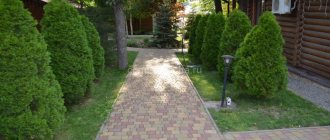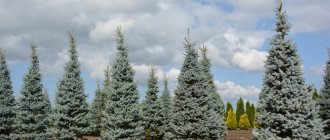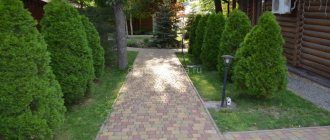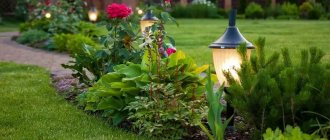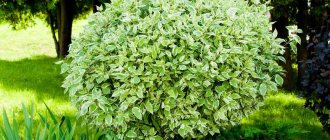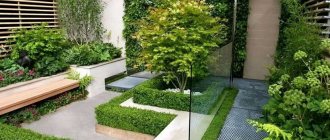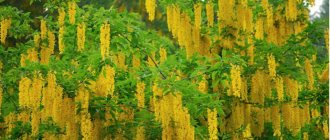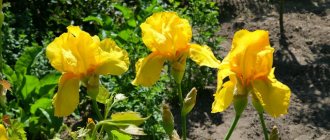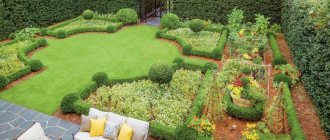In summer, the thin branches of spirea are completely covered with small bright green leaves, and in winter they gracefully bend to the ground under the weight of snow. The shrub is especially magnificent during the flowering period, when the inflorescences cover the stems so tightly that they seem to be dressed in a snow-white bridal outfit. The originality of the plant is reflected in the name: the ancient Greek word “speira” means bend . Indeed, spirea shoots have extraordinary flexibility, making the plant look very elegant at any time of the year.
Types of Spiraea
Spiraea is a genus of deciduous shrubs from the Rosaceae family, subfamily Spiraea. Habitat: temperate latitudes of the northern hemisphere. Subspecies of spirea vary greatly in habit; they range from 15 to 250 cm in height. Conventionally, they are divided according to flowering time: early flowering and late flowering. The first of them bloom in late May - early June, bloom profusely, but not for very long. Small white flowers are collected in corymbose, umbellate, and less often paniculate inflorescences.
Spring flowering spirea:
- S. Vangutta is a shrub up to 2 m high with bluish-green diamond-shaped leaves, which make the plant decorative throughout the summer season. Under favorable weather conditions, re-blooming is possible in August;
- S. nipponensis is a tall shrub with an almost regular spherical crown. The foliage retains its color saturation almost until frost;
- S. average is a hardy plant whose homeland is the northeastern part of Russia. It has a powerful crown of irregular shape;
- S. oak-leaved is a very old, unpretentious species. Forms bushes up to 2 m tall, used in hedges.
Late-flowering species of spirea bloom in the summer months and are distinguished by longer, but not as abundant flowering. The flowers come in pure white, milky, red, purple and pink.
Japanese Spiraea Darts Red
The most common late-flowering spireas are:
- S. birch-leaved - yellow leaves, similar in shape to birch foliage. Blooms for a long time (from June to September) with pinkish inflorescences;
- S. loosestrife - flowering continues from late June until autumn, the bush reaches 2 m in height. The inflorescences are pyramidal in shape, dense, white or slightly pinkish in color;
- S. Bumalda is a short hybrid (75 cm). It blooms for almost 2 months, the color varies from light pink to red;
- S. Douglas is a very decorative species with foliage of an unusual silver-green color and beautiful pink inflorescences of complex shape.
Separate mention should be made of Japanese spirea, represented by many garden subspecies. Strongly branched bushes of medium height (about 1.5 m) form a dense ball.
Many forms of Japanese spirea have unusually decorative foliage in shades of yellow and purple.
Spiraea japonica Goldflame
Spiraea japonica Magic Carpet
11. Interesting facts
The name “spirea” in Latin means “spiral”, and comes from the thin, elastic branches of the bush. In Greek, the word "speira" means "bend" - and indeed, the branches of various species are often arched.
Spring-flowering plants have another name - “white bride”, as they form long, drooping inflorescences with white buds, and from a distance the bushes resemble a girl in a wedding dress.
When choosing a species, it is worth considering that some plants easily propagate by self-sowing and fill any free space in the garden.
The green parts of plants and shoots contain ascorbic acid, carotene, and spirea is sometimes used in folk medicine as a medicinal plant.
You might also be interested in:
Use in landscape design
The diversity of species allows the use of spirea in landscapes of different directions: Japanese, English, rural, pastoral, French, Russian. Low-growing species are used to create borders along garden paths and colorful curtains in green meadows.
Their root system perfectly tolerates cramped growth conditions, so plants of small habit are used in mobile landscaping of terraces, paved courtyards, patios, and pool areas.
Landscape designers use tall spirea as solitary plants, planting the bushes at a fairly large distance from one another. In this design, they look great on mowed lawns, without requiring additional decorative planting.
Free-growing hedges are picturesque, most often made up of one, less often several types of spirea.
Blooming spirea in flower beds
Spiraea are not afraid of gas pollution on city streets, so they are successfully used in landscaping parks and squares. They can often be seen in flower beds planted at the entrance to large supermarkets, entertainment venues, and administrative offices.
Where is the culture used?
Spiraea Shirobana is actively used for group plantings and as hedges. Dwarf varieties are excellent for rockeries, living carpets, and rocky gardens.
But as a single plant, spirea looks very beautiful in areas.
There are many varieties of the crop that have different flowering periods. The popularity of the plant is associated not only with the beauty of its flowers, but also with its unpretentiousness. In addition, spirea seedlings are inexpensive, which means everyone can buy them for themselves. Having your own plant on the site, in the future you can easily grow seedlings yourself. Spiraea Shirobana is good for landscape design. From plants you can create decorative borders and entire compositions that will decorate your garden plot. Spiraea is an excellent material for cutting; the plant can be given a variety of shapes. But, unfortunately, it will not bloom. In general, Shirobana spirea is a universal plant that can decorate a summer cottage.
Reproduction
To obtain new spirea bushes, vegetative propagation methods are most often used, which make it possible to preserve their varietal characteristics.
The main methods of propagation of spirea:
- Cuttings;
- By layering;
- Dividing the bush.
Cuttings are cut from the middle part of last year's shoots at the beginning of summer and planted in boxes with a light substrate. You can also plant cuttings directly into the ground in the shade of trees, adding sand and peat to the planting groove. For successful rooting, the soil is not allowed to dry out, and a canopy is made of translucent film over the bed. By autumn, a fairly developed root system is formed on the cuttings. To preserve planting material, it is covered with a thick layer of mulch, spruce branches or leaves during the winter months. In the spring, when the buds on the young plants swell, they are transplanted to a permanent place.
Reproduction by layering is somewhat simpler and gives a higher survival rate. In early spring, the not yet leafy shoots bend to the ground and dig in. To prevent the shoot from being accidentally pulled out during weeding, it is pinned with a metal or wooden bracket. During the summer, the cuttings are watered abundantly, which promotes their rapid rooting, and next spring they are separated from the mother plant with pruning shears and replanted.
Attention! Growing spirea from seeds is carried out only in the case of species varieties. In early spring, seeds are sown for seedlings in boxes, and when the seedlings reach 10-15 cm, they are transplanted into open ground.
Care
Regular and proper care of spirea is the key to its beautiful appearance, freshness and lush flowering. The plant is a moisture-loving plant, so it requires regular watering. The lack of the required amount of water has a detrimental effect on the growth rate of the shrub and on the quality of its flowering. In hot, dry weather, the crop needs to be moistened every two weeks, using at least 10 liters of water per plant.
Learn about the features of growing spirea of the Little Princess variety.
Mandatory spirea care procedures include loosening and weeding the soil. The first activity is carried out after each moistening, going deep into the soil up to 6 cm. Loosening allows you to enrich the soil with oxygen and minerals, thereby accelerating the growth of the root system. As the weeds grow, they are weeded. It is especially important to remove all weeds before they begin to bloom.
Despite the fact that Jenpei is characterized by excellent frost resistance, it does not hurt to cover it for the winter with agrofibre or any breathable, breathable material, after carefully bending the branches to the soil.
Features of cultivation
Spiraea thrives on all types of soil; only heavy clay soils should be avoided, especially in combination with groundwater close to the surface and swampy areas. The planting site should be sunny and open. Even a light shadow can affect the decorative appearance of the plant, as it reduces the abundance of flowering.
Landing
The most favorable time for transplanting fully formed spirea bushes is autumn, when the plant has almost completely shed its foliage. The planting hole is prepared 20-30 cm wider than the clod of earth on the roots, drainage is arranged at the bottom from small crushed stone, broken brick or coarse sand, and a cushion of garden soil mixed with humus and sand is poured. If the soil on the site is quite fertile, there is no need to fill the hole with soil mixture; you can simply pour a layer of previously selected soil onto the drainage.
The plant is lowered into the hole, the roots are sprinkled with soil and watered. If the bush has settled, it is pulled up so that the previous place of growth is at soil level. After this, the plant is watered again, and the soil in the tree trunk circle is mulched.
Planting material obtained by cuttings and layering can be planted both in spring and autumn, it all depends on the condition of the plant. If it has not had time to become strong enough, it is better to wait another season until the seedling comes into force.
Watering
Since the root system of spirea does not lie deep, the plants need regular watering. Low-growing species are especially demanding of soil moisture. You can reduce the frequency of watering by mulching: the soil is covered with crushed bark, nut husks or peat in a layer of up to 4 cm . After watering, loosening must be carried out around young plants to increase soil aeration.
Important. In mid-autumn, all spirea bushes are watered abundantly - this measure helps the plants more easily endure the winter dormant period. Watering is especially important in dry autumn.
Shelter for the winter
Spiraea are quite frost-resistant and do not need shelter for the winter. Moreover, in the case of tall species, this is quite difficult to do. To protect plantings from frost in the northern regions of Russia, in the fall the tree trunk circle is covered with fallen leaves or covered with spruce branches. After the first snowfall, the bushes are completely covered with snow. These measures are sufficient to preserve the plants until spring.
Reviews of Billard's spirea
Manokhina Irina Pavlovna, 55 years old, Naberezhnye Chelny About 20 years ago I planted 2 small bushes of Spiraea loosestrife on the plot, which simply filled the entire garden with its wild growth. At first I mowed it, then I had to use herbicides and completely dig up everything. About 3 years ago I found out that there was a hybrid - Billard's spirea, and decided to plant it. Judging by the photo, Billard's spirea can hardly be distinguished from the loosestrife, but in terms of growth style, it is heaven and earth. It sits in a neat bush, pleases with abundant flowering; if there are offspring, there are very few of them.
Suvorova Elena Borisovna, 36 years old, Alexandrov Several years ago we built a house on the site, and it was time to improve the territory. I decided to arrange something like a mixborder with Billard's spirea in the center. In the company of Chinese gypsophila, sedum and Caucasian ash it looks amazing!
Trimming
In spring-flowering spireas, flower buds are formed on branches of 2 and 3 years of age, as well as on last year's shoots. Therefore, to prevent the abundance of flowering from decreasing, only sanitary pruning is carried out: in early spring, even before the buds swell, broken and dry branches are removed. Bushes need rejuvenation once every 8 years. It is carried out in two ways:
- All shoots, both old and young, are cut out. Remain low above the soil (10 cm) hemp;
- All old shoots are cut out, and young shoots age 1-2 years, are left.
Spiraea is very viable and recovers quickly. Already by the middle of the growing season, an increase in green mass occurs, and the next year the plant blooms again.
Summer-flowering species can be pruned in spring, autumn or immediately after flowering. Last year's shoots are shortened by ¼ length. This stimulates the formation of lateral branches, the bush becomes more magnificent, and its decorative effect increases. Anti-aging pruning is planned once every 5 years .
A hedge of low-growing Japanese spirea
Different pruning approaches should be used for tapeworms and hedges. In a hedge, it is important to create an impenetrable, dense curtain. Old branches are shortened by almost half. This stimulates the growth of side branches and makes the bushes denser. In single plantings, it is important to preserve the decorative appearance of the plants, so the shoots, especially young ones, are not shortened.
Important. In low-growing varieties of spirea, the growth of mass does not occur very intensively, which means they should be pruned with caution. In most cases, it is enough to remove weak and damaged branches.
Useful video on pruning:
Diseases and pests
Spiraea is little susceptible to disease and almost does not attract pests. The only exceptions are weak, depleted plants that are unable to resist fungal infections and insect infestations.
Insect pests that attack spirea:
- Aphid. To combat aphids, spraying with Actellik or Fozalon is carried out. Among folk remedies, treatments with garlic tincture are effective;
- Whitefly. To combat the pest, Denis Profi is used, as well as a solution of laundry soap;
- Rose leaf roller. Destroyed by Fitoverm and copper sulfate;
- Spider mite. Causes the most significant damage; its presence is determined by a white coating on all parts of the plant. For destruction, the chemicals Metaphos, Phosfamide, Keltan and Fozapon are used.
- Meadowsweet sawfly. Denis Profi and Fitoverm are used for fighting.
Pests are detected visually during inspection of the bush. Neutralization measures are carried out as early as possible so that insects do not have time to cause significant harm to the plant.
When infected with fungal infections, Fitosporin and Fundazol are used, as well as Bordeaux mixture.
Spraying with antifungal drugs is carried out 2-3 times per season with an interval of 7-10 days .
If the treatments are not effective, it is recommended to get rid of the diseased plant by removing it completely from the area. This radical precaution will help protect healthy plants from infection. dizlandshafta
Compatibility with herbaceous plants
In a flower garden, spirea is always a welcome guest. Both perennials and annual plants are combined with it:
- spring blooming: tulips, daffodils, irises, primroses, muscari, scillas;
- shade-loving: hostas, periwinkles, mantles; sedums, sedums;
- decorative bows (alliums): Suvorov, Schubert, Ostrovsky, blue, Molya: Aflatunsky, fistula;
- tall and miniature perennials: peonies, lupins, phlox, daylilies, roses, astilbes, aquilegias, aconites, delphiniums; violas, pyrethrums, forget-me-nots;
- brightly flowering annuals: petunias, lobelias, nigellas, cosmidiums, felicias;
- ornamental grasses: miscanthus, feather grass, reed grass, molinia, pearl barley, fescue.
By the way, if there is an unattractive outbuilding on your site, plant a tall spirea, such as gray or Vangutta, next to it. When the bush grows, and this will happen quite quickly, the unsightly shed or modest firewood shed will cease to be “extra” elements and will become full-fledged participants in the composition.
Date: November 20, 2019.
Updated: 05/18/2021
